|
|
|
Sort Order |
|
|
|
Items / Page
|
|
|
|
|
|
|
| Srl | Item |
| 1 |
ID:
133827
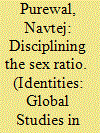

|
|
|
|
|
| Publication |
2014.
|
| Summary/Abstract |
The 'girl child' has attracted a considerable amount of attention in India as an object of policy addressing gender discrimination. This article examines the field of campaigns seeking to address female foeticide and positions the public discourse on the 'girl child' and sex selective abortion in India within a broad cultural backdrop of son preference. The article argues that anti-female foeticide campaigns exist within a disciplinary domain of female foeticide which both generates a discourse of saving the 'girl child' and also shows attempts to utilise both incentives and punitive measures in carving out a female foeticide carceral space.
|
|
|
|
|
|
|
|
|
|
|
|
|
|
|
|
| 2 |
ID:
193004
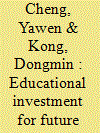

|
|
|
|
|
| Summary/Abstract |
Numerous studies have shown that a sex ratio imbalance (more boys than girls in a society) may result in a sequence of social problems. This study investigated the expected effect of a high sex ratio on educational investment. Using nationally representative data from the China Family Panel Studies and the 2010 Census, we determined the following: (i) a high sex ratio increased educational expenditure for boys relative to girls; (ii) parents who took education seriously and who cared about their children's education were more likely to invest in education to appear attractive in the future marriage market, and (iii) the profound impact of a high sex ratio on educational expenditure was more pronounced in less educated and poorer families. Our findings raised the possibility that the effect of the sex ratio may bring about more gender inequality in the future. The implicit cost of a high sex ratio may further lead to a vicious cycle of family fertility and childbearing.
|
|
|
|
|
|
|
|
|
|
|
|
|
|
|
|
| 3 |
ID:
167246
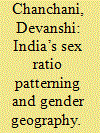

|
|
|
|
|
| Summary/Abstract |
From an interpretation of gender relations in the Chhattisgarhi plains of central India, this paper contributes to theoretical debates on the regional geography of female autonomy and its economic or cultural underpinnings. It seeks to unpack the multi-layered dynamic of gender relations in Chhattisgarh that defy easy generalisation. Kinship systems for non-adivasi groups follow important ‘northern’ or exogamous principals, which are argued, by Dyson and Moore’s thesis, to be unfavourable to female power or autonomy. Counter-intuitively, gender relations are relatively egalitarian when judged by indicators such as sex ratio, and attitudes towards female sexuality or remarriage, while son-preference in the family composition finds a sharp expression. Whereas Chhattisgarh displays unique cultural characteristics, the dependence on women’s labour in the state’s rice-based agrarian economy may make women’s position less susceptible to subordination, and conceivably mitigate the predicted unfavourable-to-women effects of exogamous marriage.
|
|
|
|
|
|
|
|
|
|
|
|
|
|
|
|
| 4 |
ID:
183242
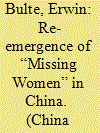

|
|
|
|
|
| Summary/Abstract |
Empirical evidence suggests that close to 100 million women are “missing” worldwide. We revisit the empirical evidence for China, the country with the most missing women. Nearly ten million girls born in the 1980s and 1990s who were “missing” according to earlier census data can be found again in the 2010 population census. We discuss two possible explanations for the re-emergence of these formerly missing girls: the delayed registration of girls owing to economic reasons, and the response to amendments to the Chinese Statistics Law in 2009 and policy changes in the 2010 population census. Using the most recent statistics, we document patterns of the underreporting of women over time and across regions as well as explore the basic determinants of underreporting of women. Important policy challenges remain. For the unregistered children, the lack of access to public services will increase their vulnerability and adversely affect their quality of life.
|
|
|
|
|
|
|
|
|
|
|
|
|
|
|
|
| 5 |
ID:
101496
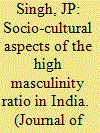

|
|
|
|
|
| Publication |
2010.
|
| Summary/Abstract |
The paper aims to explicate those factors accountable for the continuing imbalance in the sex ratio and its further masculinization over the whole of the 20th century. Here it is contended that the traditional practice of female infanticide and the current practice of female foeticide in the contemporary period, especially in the north-west and Hindi-speaking states, have significantly contributed to the high masculinity ratio in India. In addition, increasingly higher survival ratios of male children, particularly from the 1951 census onward, have been the prime reason for a declining proportion of females in the Indian population. As the Indian value system has been imbued with a relatively higher preference for sons, improvements in health facilities have benefited males more than females, giving rise to a highly imbalanced sex ratio in the country. This scenario, however, has steadily tended to alter in favour of greater balance in sex ratio.
|
|
|
|
|
|
|
|
|
|
|
|
|
|
|
|
| 6 |
ID:
169794
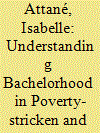

|
|
|
|
|
| Summary/Abstract |
Coupled with the social practice of female hypergamy, the male surplus within the never-married population means that today's Chinese marriage market is extremely tight in particular for men from a rural background and the least privileged socio-economic categories. Drawing on quantitative data from a survey conducted in 2014–2015, this article sheds light on the situation of single men who are past prime marriage age in three rural districts of Shaanxi particularly affected by this phenomenon. It compares single men's characteristics to those of their married counterparts and offers insights into the heterogeneity of single men with the aim of challenging some commonly accepted assumptions about bachelorhood in rural China. Results suggest a strong internalization of the various characteristics, centred on being able to offer social mobility to a potential wife, that a man is expected to have to be attractive to women in a context where women have more choice in mate selection. We conclude that mate selection is highly marked by class, social norms, social interactions, health, generation and age, and requires the mobilization of certain amounts of individual, social and economic resources. Unwanted bachelorhood would thus be better understood using an intersectional approach rather than mainly in numeric terms.
|
|
|
|
|
|
|
|
|
|
|
|
|
|
|
|
| 7 |
ID:
113691
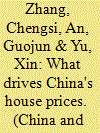

|
|
|
|
|
| Publication |
2012.
|
| Summary/Abstract |
The high and rising house prices in China are not adequately accounted for the traditional explanations emphasizing demand-driven or cost-push factors. Recent published studies claim that gender imbalance increases competition among men in the marriage market, which has pushed Chinese, especially parents with a son, to buy houses as a signal of relative status in the marriage market; this marriage competition then causes high demand for houses and eventually leads to rising house prices in China. Empirical results in this paper, however, provide little support for this hypothesis and we find that a rise in the sex ratios for most age cohorts accounts for very small percentage variations in house price movements in China during 1998-2009. Further investigation suggests that excess demand driven by high monetary growth was a significant cause of the rising house prices in China during 1998-2009. Therefore, the impact of gender imbalance on house prices should not be exaggerated and monetary dynamics remains an important leading indicator for house price movements in China.
|
|
|
|
|
|
|
|
|
|
|
|
|
|
|
|
|
|
|
|
|